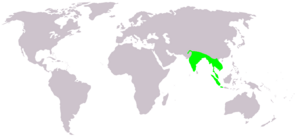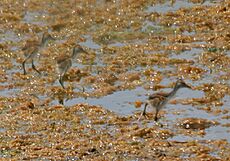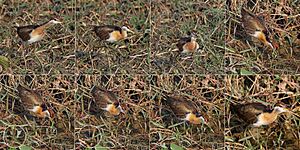Bronze-winged jacana facts for kids
Quick facts for kids Bronze-winged jacana |
|
|---|---|
 |
|
| Bronze-winged jacana |
|
| Conservation status | |
| Scientific classification | |
| Genus: |
Metopidius
|
| Species: |
indicus
|
 |
|
| Synonyms | |
|
Parra indica protonym |
|
The bronze-winged jacana (Metopidius indicus) is a type of wader bird. It belongs to the Jacanidae family. You can find these birds across South and Southeast Asia. It is the only species in its genus called Metopidius.
Like other jacanas, this bird walks on water plants. It uses its long feet to spread its weight. This stops it from sinking into the water. Male and female bronze-winged jacanas look similar. But females are a bit bigger. They are also polyandrous. This means one female mates with several males. She keeps a group of males during the monsoon breeding season.
Males protect their own areas. One male from the group is chosen to sit on the eggs. He also takes care of the young birds. If danger comes, the male can carry his baby chicks. He tucks them safely under his wings.
Contents
About the Bronze-winged Jacana Name
The bronze-winged jacana was first described in 1790. An English bird expert, John Latham, gave it the name Parra indica. Later, in 1832, a German zoologist named Johann Georg Wagler created the genus Metopidius. The bronze-winged jacana is the only bird in this group.
The name Metopidius comes from an ancient Greek word. It means "on the forehead." This refers to the special flap of skin on the bird's head. The word indicus is Latin for "Indian." This tells us where the bird is found. There are no different types or subspecies of this bird.
Like other jacanas, this bird has 10 tail feathers. It also has an oil gland that helps keep its feathers healthy. Many jacana species have a small spur on their wings. This spur is used when they fight over their areas. The bronze-winged jacana has a very small spur.
In some jacana types, the wing bones are shaped differently. This might help them fight or carry their eggs and young. Male jacanas are known to hold eggs under their wings. This special way of carrying eggs might be helped by their unique wing bones.
What Does a Bronze-winged Jacana Look Like?
Bronze-winged jacanas are large birds. They look a bit like rails. From far away, they seem dark. But they have a clear white stripe above their eyes. These birds are about 29 centimeters (11 inches) long. Females are a little bigger than males.
Their wings are a shiny bronze-brown color. They have a green glow. The head, neck, and chest are black. This makes the wide white stripe above the eye stand out. This stripe goes all the way to the back of the neck. The lower back and tail feathers are a chestnut color.
The tail is short and reddish-brown. It has a black band at the end. The bill is greenish-yellow. The top part of the bill is red at its base. A reddish-purple flap of skin, called a frontal shield, sits on its forehead. The legs are greenish. Their toes are very long. The nail on the back toe is longer than the toe itself.
Baby chicks are light brown. They have a dark stripe down their neck. Young birds have brown upper parts. Their crown is reddish-brown. Their undersides are white. They have a buff-colored front neck. Their frontal shield is not fully grown yet. They might also have a faint stripe above their eye.
Adult bronze-winged jacanas can sometimes be mistaken for other birds. These include the common moorhen or the watercock. Young jacanas might look like young pheasant-tailed jacanas. But they do not have the black necklace that pheasant-tailed jacanas have.
Where Do Bronze-winged Jacanas Live?
These birds live across the Indian Subcontinent. You won't find them in Sri Lanka or western Pakistan. They are also found in Southeast Asia. They mostly live in low-lying areas. Both the bronze-winged jacana and the pheasant-tailed jacana can live in the same places.
These birds usually stay in one area. But they might move around if there is a drought or heavy rains. They can live in wetlands that have plants like water hyacinth. They also use plants like Ipomoea aquatica for cover when they are breeding.
Behavior and Life Cycle

Bronze-winged jacanas are usually seen alone or in pairs. They walk on water plants to find food. They balance well on their long legs and toes. They eat insects and other small creatures. They pick these from the floating plants or the water's surface. They also eat some plant material.
Their call sounds like a wheezy seek-seek-seek. They mostly make this sound when they are alarmed. If they feel threatened, they sometimes hide. They do this by going underwater. The breeding season starts after the rains. In India, this is usually from June to September.
Males protect their areas from other males. They do this by spreading their wings and stretching their necks. Sometimes, these displays can turn into pecking fights. Males are most active in defending their areas in the morning.
The nest is a small platform. It is made of stems and leaves from water plants. These include Pistia, Nymphoides, Hydrilla, and Eichhornia. Sometimes, eggs are laid right on a lotus leaf. A female usually lays four eggs. The eggs are cone-shaped and shiny brown. They have black zig-zag marks.
The male bird does all the work of sitting on the eggs. He also takes care of the young. The eggs hatch in about 29 days. Many eggs are lost to predators. These can include other birds and turtles. Young chicks can be carried to safety by the male. He shelters them between his wings. They become independent from their father when they are about ten weeks old.
Reproduction and Mating System
Bronze-winged jacanas have a special way of reproducing. The female is bigger and protects her area. She is polyandrous. This means she mates with several males. She competes with other females to have a group of males. These males will sit on her eggs.
Each female's area can include one to four males. Each male has his own small area within her larger one. Females mate with many males. If a male receives eggs to incubate, he might destroy them. This happens if he is not sure if the eggs are his.
Males make a loud yelling call to get the attention of females. Males yell more when they are part of a larger group of males. Females seem to use these yells to decide which male is best. They tend to mate with males who yell more.
Images for kids








